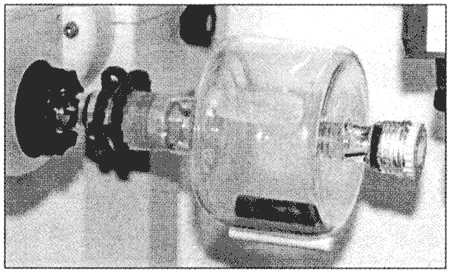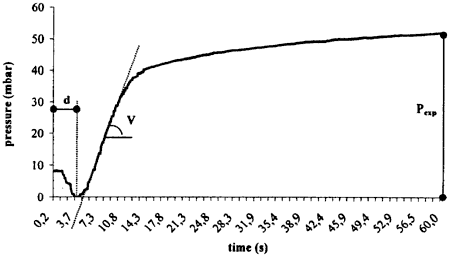From the results obtained the author concludes that:
・from one type of additive to another, significant variations of neutralization speed exist.
・the soap content, the nature of the alkylate of the detergent and the manufacturing process contribute directly to neutralization speed changes.
・the effect of dispersants or base oils on the neutralization speed is strong, which shows that the oil formulation is much more important than the neutralization ability of an overbased additive itself.
2. EXPERIMENTS
All the experiments have been conducted under the following experimental conditions:
・mass of the sample : 2g
・H2SO4cc molar excess: 96.7%
・temperature : 100℃
・BN range of the sample: 70mg KOH/g
・viscosity grade of the sample : SAE50
・measuring time : 60s or more
・number of measurements per sample : 5 or more
2.1 - NAMO method
The apparatus used for NAMO experiments has been detail [5]. The Fig. 1 shows the device.

Fig. 1 - NAMO apparatus
The principle of the NAMO method is based on the measurement of the variation in pressure due to carbon dioxide (CO2) production when concentrated sulfuric acid is added to a lubricant sample. The CO2 is produced during the neutralization reaction that occurs in a thin film of oil formed by mean of two self-attracted magnetic bars in a rotating cylindrical glass reactor. Fig, 2 shows the reactor.
The instantaneous pressure values are recorded vs time on a computer with fast acquisition software and are printed as shown on Fig. 3. From these data the neutralization speed, V, expressed in pressure unit per time unit (mbar/s) is determined.

Fig. 2 - NAMO's cylindrical glass reactor
2.2 - Parameters identification
Three characteristic parameters shown on Fig.3 are identified from the pressure recording:
・the initiation delay, d, expressed in time unit (s)
It corresponds to the time lapse between the origin of the recording and the moment at which the pressure starts to increase because of CO2 production.
・the reaction speed, V (mbar/s)
It corresponds to the slope of a straight line that can be satisfactorily fitted to the rapid initial pressure variation.
・the experimental pressure variation, Pexp(mbar)
It represents through the CO2 production the amount of basicity consumed during the reaction. From Pexp another parameter, BNu , is calculated. BNu is expressed in percentage (%) of the total available basicity assuming that it is coming from the calcium carbonate (CaCO3) only.

Fig. 3 - Typical shape of the recorded pressure curves
2.3 - Overbased additives tested
Four different kinds of additives used to formulate the marine lubricants have been tested: the sulfonate detergents, the phenate detergents, the salicylate detergents and the polyisobutene succinimide dispersants (PIB-succinimide).
2. 3. 1 - Sulfonate detergents
The sulfonate detergents that have been tested are described in Table 1. They are commercially available additives obtained from additive suppliers and specifically designed products provided by CROMPTON CORPORATION. For the latter, parameters such as the alkylate nature, the soap content, the metal nature or the crystalline form of the base species were varied. Some parameters related to the manufacturing process such as the catalyst used for the alkylation of the detergent or the rate of lime carbonation enhancing additive were also varied.
BACK CONTENTS NEXT